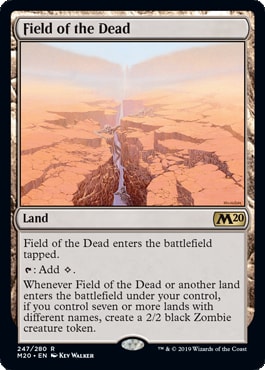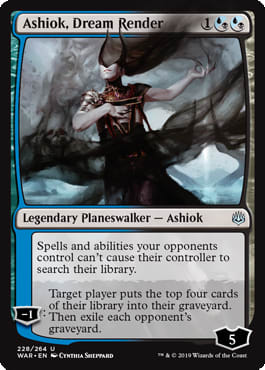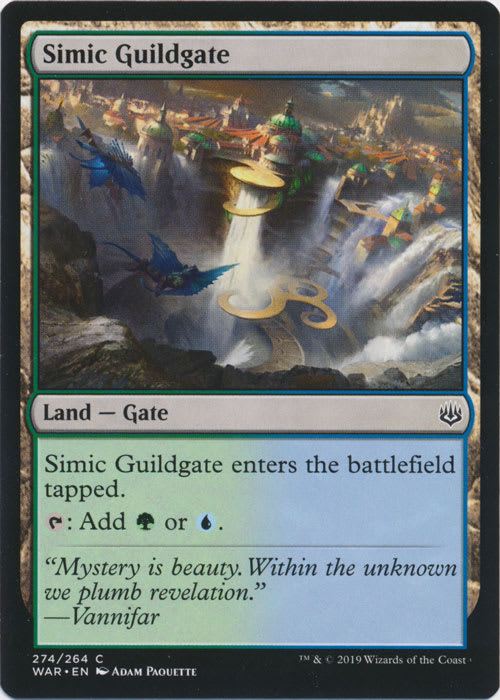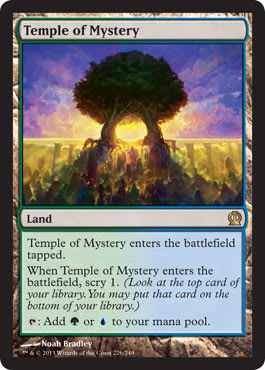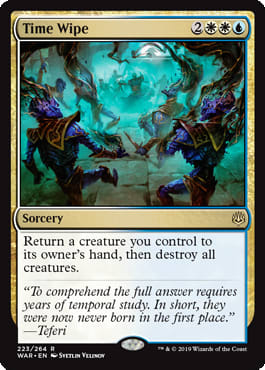Everything Proceeds from Field of the Dead
Meet Field of the Dead:
This new land from Core Set 2020 is the one card that really makes the Scapeshift deck. As you will see throughout this Top 8 list, there are multiple things that the Scapeshift decks can accomplish... But no one would be sleeving the Modern staple up in Standard without Field of the Dead.
This land asks a couple of things - specific things - but gives the deck a combo-like payoff if you do them.
The minimum bar is getting seven lands in play. You don't actually have to have seven different lands in play to start, because Scapeshift can work all that out for you if you resolve it. To that end, the deck's construction is very specific, and very biased.
First of all, the average Scapeshift deck has twenty-eight or even twenty-nine lands. On top of those, they play cards like Circuitous Route and Arboreal Grazer to not just find or select lands, but - in the eminently plausible case that you already have a handful - you can just get them on the battlefield in a hurry.
The Plan A of the Scapeshift deck is - starting with at least seven lands - to resolve Scapeshift. That's not super hard to do. The most popular iteration of the deck has Teferi, Time Raveler. Most others can play cards like Negate, Dovin's Veto, or Veil of Summer as cover spells. You might even be able to play two if you have seven lands in play!
You don't need Scapeshift to make Field of the Dead good, though. If all you have is the lands, you can play a land per turn (which shouldn't be easy given how many lands are in the deck), you can net a free 2/2 creature each turn. With multiple copies of Field of the Dead? I think you know where this is going.
Scapeshift is Mostly Non-Interactive
Unless you have specialized cards like Cry of the Carnarium or Deputy of Detention in your deck, the Scapeshift endgame can be pretty irresistible (even if it doesn't win outright, immediately).
You can play your Scapeshift at the end of the opponent's turn with Teferi, Time Raveler; which can kind of give the creatures a quasi-haste. If you're instant-ing out your Field of the Dead tokens, there is rarely much opponents can do to defend themselves. They're probably going to get attacked for a bunch; and if you have eight or more lands you might just kill them on the spot.
Scapeshift can get into a dominating position fast enough to resist most conventional offenses. Unless you are playing hand destruction or burn spells, it can be difficult to kill them before they have enough lands in play to combo off.
A lot of what most decks try to do doesn't really matter to Scapeshift. They can make more guys; they can make good blocks; they can set you up for the fall during your own combat. What's worse is that a lot of Scapeshift's tools actually help to buy them time. Arboreal Grazer is an outstanding blocker for only one mana. Elvish Rejuvenator is probably just a chump; but it's a chump that got you ahead a turn.
See? Now this is a problem. Some Scapeshift players have adopted Nexus of Fate tech to just buy time. Wide? Tall? Doesn't matter. Scapeshift is largely playing solitaire.
Ashiok, Dream Render is a Good, But Not Perfect, Solution
When LSV won Grand Prix Denver a week ago, the first answer to this wonderful deck I thought of was Ashiok.
As you can see, the winner of the most recent big Standard event sided a copy (presumably for the mirror):
Bant Scapeshift | Core Set 2020 Standard | Chris Andersen, SCG Classic Columbus
- Creatures (12)
- 4 Arboreal Grazer
- 4 Elvish Rejuvenator
- 4 Hydroid Krasis
- Planeswalkers (4)
- 4 Teferi, Time Raveler
- Instants (4)
- 4 Growth Spiral
- Sorceries (12)
- 2 Grow from the Ashes
- 2 Time Wipe
- 4 Circuitous Route
- 4 Scapeshift
- Lands (28)
- 1 Plains
- 2 Forest
- 2 Island
- 1 Azorius Guildgate
- 1 Blast Zone
- 1 Blossoming Sands
- 1 Field of Ruin
- 1 Hinterland Harbor
- 1 Selesnya Guildgate
- 1 Simic Guildgate
- 1 Sunpetal Grove
- 1 Temple of Malady
- 1 Thornwood Falls
- 1 Tranquil Cove
- 2 Breeding Pool
- 2 Hallowed Fountain
- 2 Temple Garden
- 2 Temple of Mystery
- 4 Field of the Dead
- Sideboard (15)
- 3 Veil of Summer
- 2 Dovin's Veto
- 1 Ashiok, Dream Render
- 2 Deputy of Detention
- 3 Root Snare
- 2 Baffling End
- 2 Ixalan's Binding
Ashiok has three big things going for it.
Ashiok's static ability shuts down both Scapeshift and Circuitous Route. In some builds, it will even stop Evolving Wilds!
Ashiok's cost is important because you can sneak it under these key fours. Use the [-1] or not; the average Scapeshift deck will not be able to pressure a Planeswalker with creature damage efficiently.
Now as for that [-1] ability...
The average Scapeshift deck has something like twelve singleton lands. Randomly hitting some can severely blunt the effectiveness of even a Field of the Dead that is already in play. The deck also has few big win conditions outside of the Scapeshift + Field of the Dead combo itself. Every Hydroid Krasis you randomly tag with your Ashiok is dramatically more helpful than against the average opponent.
Ashiok isn't just a card for the mirror. It's a very nice two-three punch following Hero of Precinct One; and while a little off-brand, can fit into decks from Simic Flash to Mono-Blue Tempo.
So what makes it good... But imperfect?
Ashiok doesn't actually shut the Scapeshift deck down. If you have Field of the Dead and enough lands, you can feel free to trigger it. It's good! Just not perfect.
The deck can largely be neutralized by Unmoored Ego.
While still a Dimir 3-drop, Unmoored Ego is a bit harder to cast than Ashiok. If you time it right, it does a whole lot of damage to the Scapeshift deck, though!
What should you name?
If your opponent doesn't already have Field of the Dead in play, I'd recommend that one. You can name lands with Unmoored Ego, so you might as well exercise the option. Sure, they'll still have Hydroid Krasis potential, but Scapeshift will go from five stars to nearly dead draw.
If they already have a Field in play, Scapeshift will probably be the best card to name. The opponent will still have access to the slow Field plan; but it will be just that: slow.
Speaking of Unmoored Ego: Seven, Eight, Seven Again
The most notable Unmoored Ego deck of the format (so far) is probably Nathan Holiday's Golos Scapeshift:
Golos Scapeshift | Core Set 2020 Standard | Nathan Holiday, 11th Place Grand Prix Denver
- Creatures (11)
- 3 Golos, Tireless Pilgrim
- 4 Cavalier of Thorns
- 4 Elvish Rejuvenator
- Instants (11)
- 2 Assassin's Trophy
- 2 Cast Down
- 3 Deathsprout
- 4 Growth Spiral
- Sorceries (7)
- 3 Grow from the Ashes
- 4 Scapeshift
- Artifacts (2)
- 2 The Immortal Sun
- Lands (29)
- 1 Island
- 2 Forest
- 2 Swamp
- 1 Blast Zone
- 1 Dismal Backwater
- 1 Drowned Catacomb
- 1 Jungle Hollow
- 1 Stomping Ground
- 1 Temple Garden
- 1 Temple of Malady
- 1 Temple of Mystery
- 1 Thornwood Falls
- 2 Hinterland Harbor
- 2 Watery Grave
- 2 Woodland Cemetery
- 3 Breeding Pool
- 3 Field of the Dead
- 3 Overgrown Tomb
- Sideboard (15)
- 2 Cerulean Drake
- 4 Veil of Summer
- 4 Unmoored Ego
- 2 Moment of Craving
- 3 Negate
The Golos deck is way less "Plan A" than the more common Bant archetype. Holiday has real creatures - including big bruisers like Cavalier of Thorns - and regular removal to play "fair" Magic. It also plays an oddball card in The Immortal Sun.
I mean, The Immortal Sun is pretty powerful; it can shut down decks like Command the Dreadhorde or Esper Hero... But this deck only plays eleven creatures; and three of them are Legends!
The Immortal Sun changes the math of a seven-land Scapeshift. Normally a seven-land Scapeshift can make 14 power; an eight-land one can make sixteen WAY MORE THAN THIRTY... But seven lands mean something different with The Immortal Sun in play: Twenty-one (or potentially lethal, on its face).
If they can Scapeshift, they can live
Scapeshift mana bases are necessarily diverse. Look at LSV's:
Bant Scapeshift | Core Set 2020 Standard | Luis Scott-Vargas, 1st Place Grand Prix Denver
- Creatures (12)
- 4 Arboreal Grazer
- 4 Elvish Rejuvenator
- 4 Hydroid Krasis
- Planeswalkers (4)
- 4 Teferi, Time Raveler
- Instants (4)
- 4 Growth Spiral
- Sorceries (10)
- 2 Grow from the Ashes
- 4 Circuitous Route
- 4 Scapeshift
- Enchantments (2)
- 2 Prison Realm
- Lands (28)
- 1 Plains
- 2 Forest
- 2 Island
- 1 Azorius Guildgate
- 1 Blast Zone
- 1 Blossoming Sands
- 1 Field of Ruin
- 1 Hinterland Harbor
- 1 Memorial to Genius
- 1 Selesnya Guildgate
- 1 Simic Guildgate
- 1 Sunpetal Grove
- 1 Thornwood Falls
- 1 Tranquil Cove
- 2 Breeding Pool
- 2 Hallowed Fountain
- 2 Temple Garden
- 2 Temple of Mystery
- 4 Field of the Dead
- Sideboard (15)
- 3 Veil of Summer
- 3 Dovin's Veto
- 2 Deputy of Detention
- 2 Ajani's Welcome
- 2 Ixalan's Binding
- 2 Ripjaw Raptor
- 1 Crucible of Worlds
Of course the deck plays old standbys like Hinterland Harbor and Breeding Pool... But only one and two of those. It has to make room for the other u-g duals!
Scapeshift wants the Guildgate for Circuitous Route. Temple of Mystery is just good on its face... But Thornwood Falls?
Along with Tranquil Cove and Blossoming Sands, Thornwood Falls can help the deck gain a little life on demand. In fact your first Scapeshift will often just give you three life along with however many 2/2 tokens.
In a pinch, you might want to gain three even before Scapeshift is online-online. Just to stay alive.
Veil of Summer beats Dovin's Veto
All the Scapeshift decks play Veil of Summer; most of the Bant ones play Dovin's Veto. Golos Scapeshift plays Negate, but it has much the same functionality of Dovin's Veto... Other than it can be countered.
That's the rub, though: So can Dovin's Veto (functionally). You might not be able to Counterspell that particular Counterspell, but Veil of Summer can force Scapeshift to resolve through almost anything.
Scapeshift is a Moving Target
A couple of weeks ago, Scapeshift was the runaway best deck, played by probably the best player in the Grand Prix. It certainly had things going for it, but it wasn't perfect. It exploited lack of preparation on the part of the format as a whole. While it had a Plan B, it didn't kill creatures particularly well.
But this week?
It's not just that this card gives Bant a new dimension... It gives it several. You can Time Wipe during combat like a Settle the Wreckage. You can pick up your Elvish Rejuvenator (or better yet, your Hydrod Krasis) for more and more card advantage.
This card main deck is a small wrinkle, but obviously meaningful.
The lesson? This strategy - this family of decks - is still in its infancy. Golos is barely scratching the surface of what is possible when you fit your combo kill into just four cards and your mana base. Here are some exciting ways that it can go, from this week's 5-0 MTGO decks:
Bant Scapeshift | Core Set 2020 Standard | WENWEN11
- Creatures (11)
- 3 Hydroid Krasis
- 4 Arboreal Grazer
- 4 Elvish Rejuvenator
- Planeswalkers (4)
- 4 Teferi, Time Raveler
- Instants (7)
- 3 Settle the Wreckage
- 4 Growth Spiral
- Sorceries (10)
- 3 Drawn from Dreams
- 3 Scapeshift
- 4 Circuitous Route
- Lands (28)
- 1 Island
- 1 Plains
- 2 Forest
- 1 Arch of Orazca
- 1 Azorius Guildgate
- 1 Blast Zone
- 1 Blossoming Sands
- 1 Glacial Fortress
- 1 Hinterland Harbor
- 1 Memorial to Genius
- 1 Selesnya Guildgate
- 1 Simic Guildgate
- 1 Sunpetal Grove
- 1 Thornwood Falls
- 1 Tranquil Cove
- 2 Breeding Pool
- 2 Hallowed Fountain
- 2 Temple Garden
- 2 Temple of Mystery
- 4 Field of the Dead
- Sideboard (15)
- 2 Ajani's Welcome
- 1 Clear the Mind
- 2 Deputy of Detention
- 3 Dovin's Veto
- 1 Ixalan's Binding
- 2 Ripjaw Raptor
- 1 Shifting Ceratops
- 3 Veil of Summer
Drawn from Dreams seems almost obvious, right?
Especially when you're buying time with Settle the Wreckage!
Bant Scapeshift | Core Set 2020 Standard | OOSUNQ
- Creatures (12)
- 2 Arboreal Grazer
- 4 Elvish Rejuvenator
- 4 Hydroid Krasis
- 2 Massacre Girl
- Instants (4)
- 4 Growth Spiral
- Sorceries (17)
- 2 Grow from the Ashes
- 3 Legion's End
- 4 Casualties of War
- 4 Circuitous Route
- 4 Scapeshift
- Lands (27)
- 1 Island
- 2 Forest
- 2 Swamp
- 1 Blast Zone
- 1 Dimir Guildgate
- 1 Dismal Backwater
- 1 Golgari Guildgate
- 1 Hinterland Harbor
- 1 Jungle Hollow
- 1 Memorial to Genius
- 1 Simic Guildgate
- 1 Temple of Malady
- 1 Thornwood Falls
- 1 Watery Grave
- 1 Woodland Cemetery
- 2 Breeding Pool
- 2 Overgrown Tomb
- 2 Temple of Mystery
- 4 Field of the Dead
- Sideboard (15)
- 2 Ashiok, Dream Render
- 2 Cast Down
- 3 Duress
- 2 Negate
- 3 Shifting Ceratops
- 3 Veil of Summer
Gotta say, Casualties of War is one of the most exciting innovations I can think of. Great follow-up to Circuitous Route, and utterly devastating to certain opponents. Plain old Desert Twister against others, but who's counting?
- Sun Tzu, The Art of War
LOVE
MIKE














